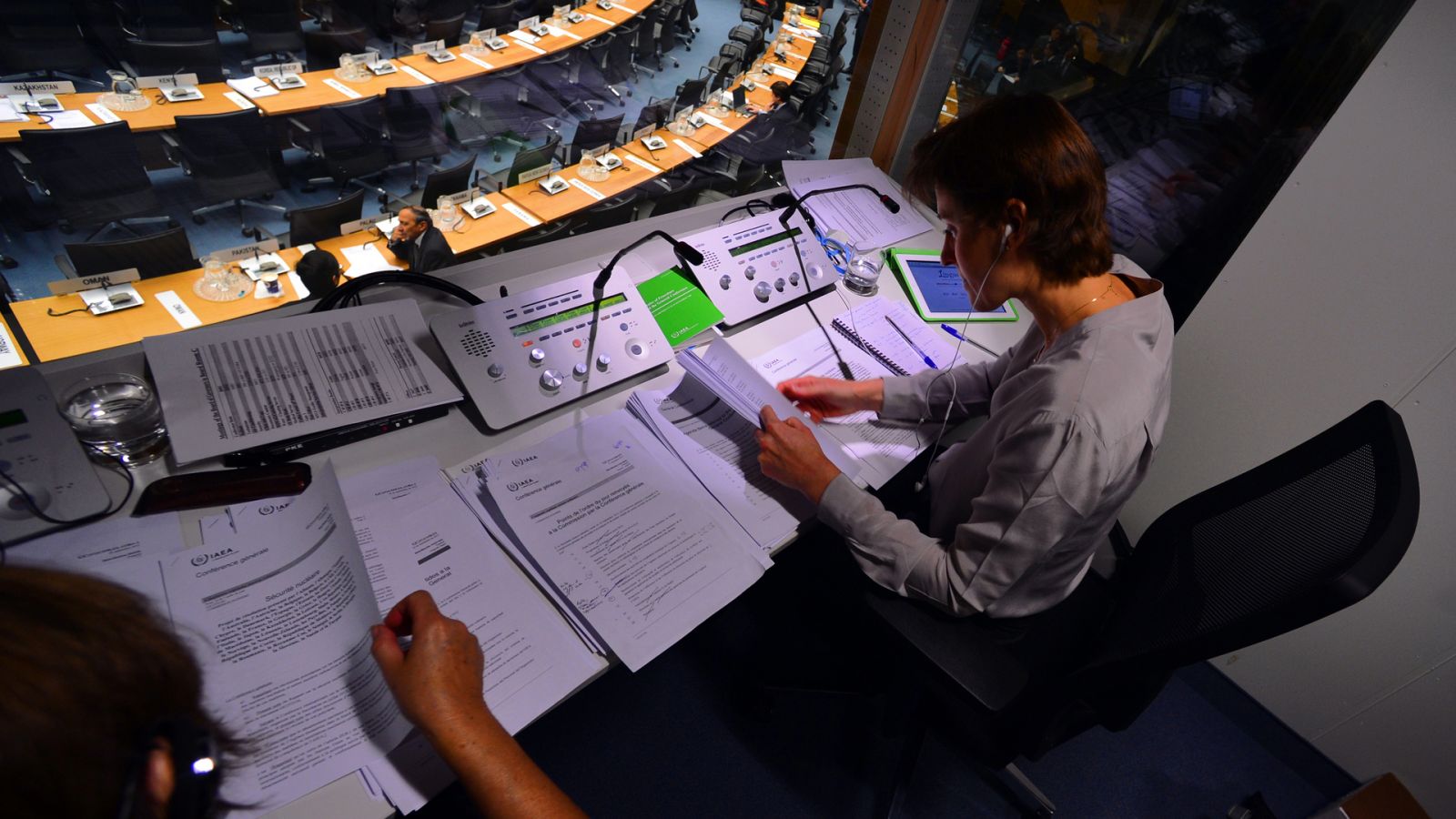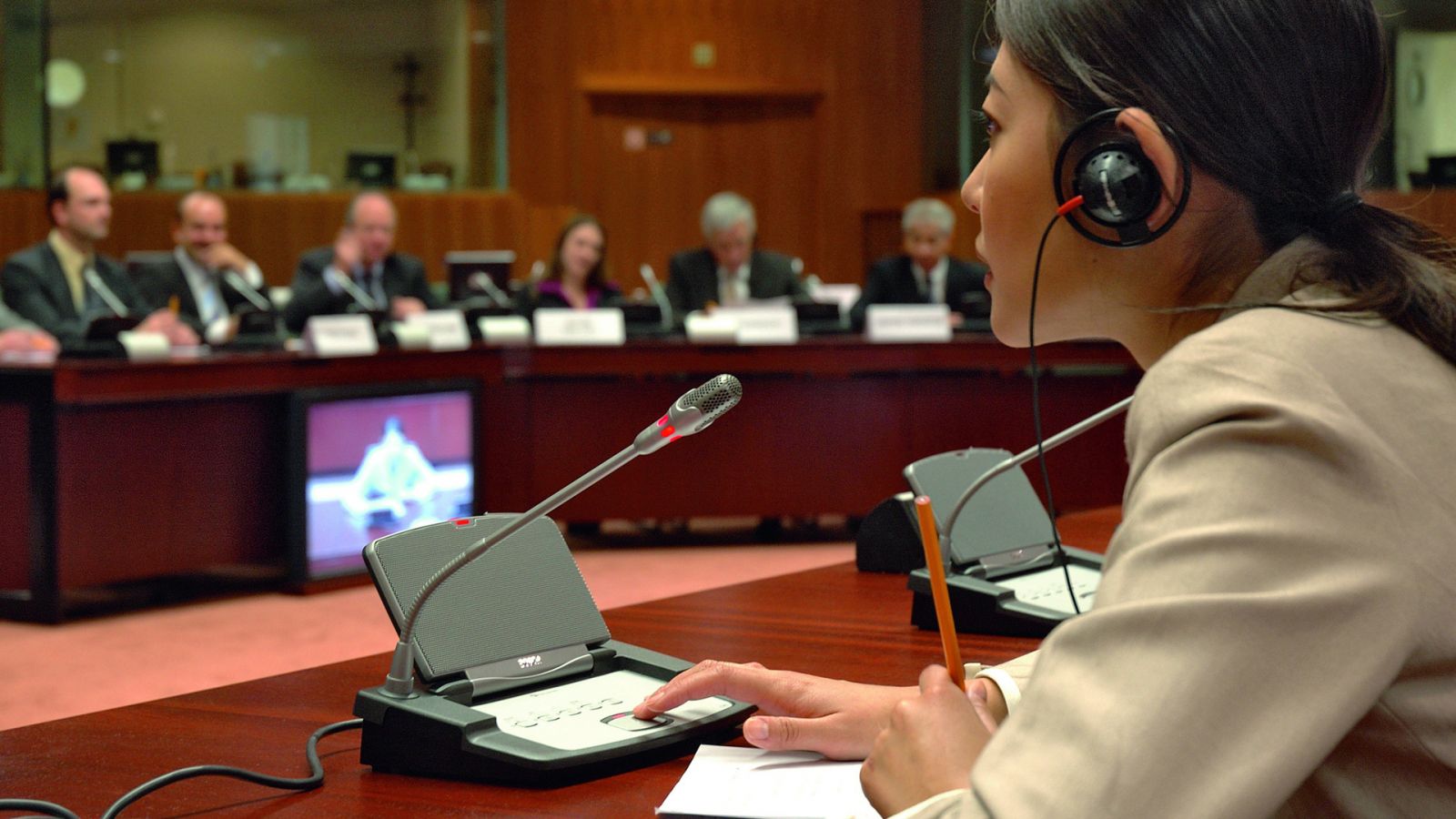Simultaneous interpretation is an interpretation service provided by qualified translators with proper technical equipment. The interpreter conveys the speech to the audience simultaneously. Simultaneous interpretation can be provided in a translation booth via equipment, as well as via online platforms. The latter is called remote simultaneous interpretation (RSI).
What Is Simultaneous Interpretation?
Simultaneous interpretation can also be referred to as “simultaneous translation”. The purpose of simultaneous interpretation, which is frequently provided at events like multinational meetings and conferences, is to translate the speech into another language at a rate that closely matches the speaker’s speech while preserving the natural flow of the speech. The interpreter simultaneously interprets what the speaker says in simultaneous interpretation.
There are three basic actions in simultaneous interpretation:
1) The interpreter actively listens to the speaker and understands everything said,
2) The interpreter swiftly decides how and when to start speaking by analyzing what is said and taking into account the linguistic structures of both languages.
3) The translator appropriately translates the speech into the target language.

What Is Important in Simultaneous Interpretation?
It is much more accurate to address the key points of simultaneous interpretation in two different ways:
1- Some key points in order to have an active presence in your target market, communicate with your customers, or introduce your company appropriately can be listed as follows:
Having a professional approach,
Remaining faithful to codes of conduct,
Taking initiative (to have the capability to translate idioms, proverbs, and cultural items accordingly),
Being familiar with the market.
2- Key points to consider during simultaneous translation may be listed as follows:
Conveying the meaning (The interpreter should start the interpretation ideally within 3 seconds after the speaker and transfer the necessary information, numbers, and phrases as well as the correct meaning to the audience),
Being able to control the voice and breath (The tone of the interpreter must not be dull and distracting for the audience),
Being able to use the equipment correctly and effectively,
Getting ready for the simultaneous interpretation (The interpreter should have prior knowledge of the names and qualifications of the speakers, analyze their accent, prepare a glossary, and be prepared using available material),
Having the ability for time management (The translator should improve themselves sufficiently in time management as the interpretation is performed simultaneously).
What Are the Roles and Responsibilities of A Simultaneous Interpreter?
Roles and responsibilities of interpreters, who play a key role in international events and meetings include:
To convey what the speaker says to the audience accurately and completely without disrupting the context and integrity,
To be sure of the accuracy of the simultaneous interpretation,
To get prepared for the simultaneous translation service,
To convey cultural elements of the known or acquired language correctly,
To convey only information and to understand their role correctly without defending any party in these languages, as interpreters can speak at least two languages spoken in the venue.
What Skills Should A Simultaneous Interpreter Have?
Simultaneous interpretation is one of the hardest procedures of all interpretation services. The interpreter needs to be proficient in both the source and target languages and has above-average language skills.
The simultaneous interpreter has far less time than the consecutive interpreter to take notes and look up term definitions while translating. For this reason, simultaneous interpreters must be highly proficient in the foreign language, be good at handling stress and improvisation, and have completed a simultaneous translation education.
How to Perform Simultaneous Interpretation?
Two interpreters work concurrently for each language pair in simultaneous interpretation, which is typically preferred for events or meetings exceeding an hour. Simultaneous interpreters translate in turn every 20-30 minutes. So, two interpreters are required to be present at all activities that are anticipated to take more than 30 minutes. While the other interpreter in the booth is interpreting, the other simultaneous interpreter attentively listens to the speaker and notes down important names and numbers. This way, interpreters working together in the same booth can create good teamwork.
It is recommended to bring the speakers and interpreters together before the event for high-quality service. If the speaker and the interpreters who will translate the speech for the audience get to know one another and ask each other questions in advance, the quality of the event will increase.
Remote simultaneous interpretation (RSI), is a service that has different elements and allows simultaneous interpreters to translate from different locations while delivering higher quality interpretation service for you with professional tools. We check the quality of the interpretation and the equipment, as well as the internet connections of our simultaneous interpreters long before the event day, and we take measures against potential issues in your remote events.
You can take a look at our blog article that we prepared for you to get detailed information on RSI.

Which Methods Are Used in Simultaneous Interpretation? What Is Relay Interpretation?
Simultaneous translation service at an event can be provided between two languages or between more than two languages. We can assign our interpreters who are in different locations to your location of preference and ensure that they are present throughout your event if there are no professional simultaneous interpreters available in the languages you choose. We can also work with translators who are nearby to the specified location and fluent in both the local language and the language of your preference if you don’t want the previous option for a certain reason.
Relay interpretation, which is widely used in multilingual meetings and conferences, entails translating the first two languages, after which interpreters in another booth translate what they hear from the first booth into different languages. This is called “relay translation” or “relay interpretation". In relay interpretation, the interpreters in the second and third booths listen to the interpreters working in the first booth, not the actual speaker. Simultaneous interpretation, which typically begins after three seconds, begins six to ten seconds later due to this transfer delay.
For instance, interpreters who are fluent in different language pairs will be needed if simultaneous interpretation in English-Polish, English-Spanish, and English-Czech language pairs is requested at an event in Warsaw, Poland. Such interpreters listen to the Polish translations from the English-Polish booth and translate into other languages accordingly. As a result, the interpretation is performed between the local language and the languages of the participants, and translation service in each language is provided at a lower price.
What Is the Difference Between Simultaneous Interpretation and Consecutive Interpretation?
While simultaneous interpretation and consecutive interpretation are among the types of interpretation, there are notable differences. While being near to the speaker is important in consecutive interpretation, seeing the speaker and the presentations (if any) is considerably more important in simultaneous interpretation. Unlike consecutive interpretation, the duration of the event is not extended with simultaneous interpretation. A maximum of three seconds after the speaker begins speaking, the simultaneous interpreter begins translating into the other language, and the translation is concluded a few seconds after the speaker is done speaking. With this service, the audience will have understood everything that was said, a few seconds after the speaker has completed the speech. We advise that you consider the timing while deciding between consecutive interpretation and simultaneous interpretation for your event.
Additionally, not all consecutive interpreters can also provide simultaneous interpretation, while simultaneous interpreters can easily provide consecutive interpretation services.

How to Handle Simultaneous Interpretation Service in a Different Country?
You might need to get a simultaneous interpretation service in a language pair in a different country, but you should be aware of your options in that country. The HeliCo Translation Team works with translators all around the world and offers simultaneous interpreters and simultaneous interpretation equipment in different countries. No matter what languages are spoken at your event, we are always ready to offer you a smooth service thanks to our skilled translators, coordinators, and technicians. Upon your confirmation, we provide you with information regarding the travel and lodging expenses of our simultaneous interpreters, and we collaborate throughout the entire process.
You can select from our various services based on your needs, and you may obtain on-site simultaneous interpretation services in many locations thanks to reasonably priced and excellent simultaneous interpretation service. Contact us for more information and let us know about your questions or concerns. We will be happy to help you out.
Why Should You Choose the Simultaneous Interpretation Service?
Simultaneous interpretation service has the following advantages for both the speaker and the audience:
It allows the translation of many languages at the same time.
It prevents loss of time during the interpretation.
Both the speaker and the interpreter can address a wider audience.
It facilitates multilingual conferences/events.
The interpreter can convey the desired message to the audience within seconds.
How Is the Simultaneous Interpretation Service Charged?
Many elements of the simultaneous interpretation service (including equipment, the country where the interpretation will be offered, atmosphere and duration of the event/conference, number of participants, and characteristics of the meeting room) are considered. It is important for you to determine your needs with your service provider. Contact us for more information on simultaneous interpretation and get the right answers to your questions and concerns to be able to receive services at an affordable price.
Written By: Gamze Korkmaz
Date of Publication: 08/09/2022
Target Audience: Those Who Need Simultaneous Interpretation Service, Those Who Want to Get Detailed Information on Simultaneous Interpretation
Software Translation Services
Software Translation Services
With the emergence of a ...
Game Localization Service
Video games, which started to become widespread in the 1980s and appeal to ...
What Is SEO? Why Do We Need SEO?
Millions of internet users utilize search engines daily to find products, access ...
Simultaneous Interpretation Equipment Service
Simultaneous Interpretation Equipment
Website Localization Services
The internet, which got involved in our lives at the beginning of the 21st century, has become an ...
Frequently Asked Questions About Localization
What Is Localization?
Localization is also known as ...
Frequently Asked Questions About Sworn Translation
What Is Sworn Translation? What Is Sworn Interpretation?
In general, ...
Frequently Asked Questions About Transcreation
What Is Transcreation?
Transcreation or creative ...
Frequently Asked Questions About Technical Writing
What Is Technical Writing?
Technical writing involves the ...
Frequently Asked Questions About Voice-Over
What Is Voice-Over?
Voice-over refers to removing the ...
Frequently Asked Questions About SEO Writing
What Is SEO?
SEO is an abbreviation for ...
Frequently Asked Questions About Proofreading
What Is Proofreading?
Proofreading means “the ...
Frequently Asked Questions About Desktop Publishing
What Is Desktop Publishing?
Desktop publishing ...
Frequently Asked Questions About Machine Translation
What Is Machine Translation?
Machine translation is a ...
Frequently Asked Questions About Article Writing
What Is Copywriting?
Copywriting is a service that ...
Frequently Asked Questions About Editing
Who Is An Editor?
An editor is the person who plans ...
Frequently Asked Questions About Transcription
What Is Transcription? What Is Transcription About?
Transcription ...
Frequently Asked Questions About Subtitle Translation
What Is Subtitle Translation?
Subtitle translation is a ...
Mobile Application Translation
What comes to mind when you think of a mobile application? Listening to music, ...
What You Need to Know About Voiceover Service
As a result of the development of technology and the more frequent use of new tools, there are ...
LocNowAndFuture - Creative Minds Come Together
A valuable virtual conference and networking event for the localization ...
We Provided Simultaneous Interpretation at the Launch for the 5th Generation, New Renault Clio
Earlier this week, we participated in the launch of the new Renault Clio in Antalya as a provider of ...
Have You Ever Considered the Remote Interpreting Service Solution?
With the recent advances in communication technology, demands for online meetings such as video ...